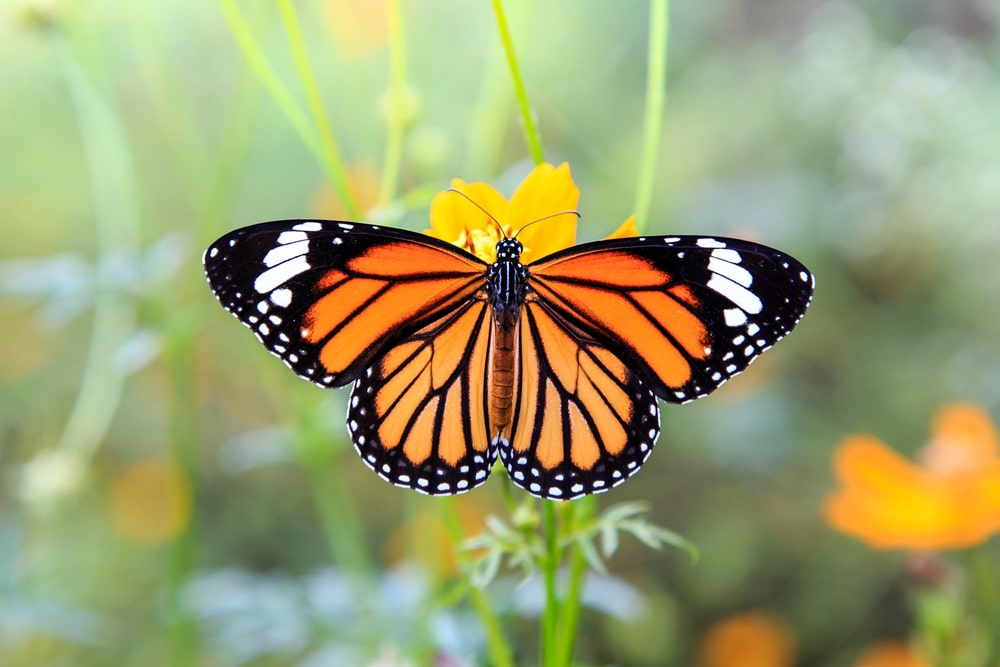My blog last week was about Milkweeds—a host plant for Monarch butterflies. I had several questions this past week about other host plants so thought I’d repost this blog from a couple of years ago.
I get so many questions about what flowers to plant for a “butterfly” garden. Well, if we don’t start planting things for the caterpillars to eat, we won’t have to worry about butterfly gardens because there won’t be any butterflies.
Here Are Some Recommended Host Plants
Passiflora, aka Passion Flower. Passiflora is a host plant for fritillary butterflies and Zebra Longwings.
Alcea, aka Hollyhocks. Host plants for Painted Lady Butterflies
Oaks, willows, maples, hawthorns, hickory, elms– (yes, some of our best host plants are trees). According to Bringing Nature Home: How You Can Sustain Wildlife with Native Plants (by Douglas Tallamy, Professor of Entomology and Wildlife Ecology at the University of Delaware), oaks are a host plant for 534 Lepidoptera (butterfly/moths) species alone; willows 455 species; maples 285 species.
Dill, fennel, parsley, rue, Queen Anne’s Lace—These are host plants for Black Swallowtail butterfly caterpillars. I love dill, but when I plant it, I always plant a couple of extra plants that are my “sacrifice” plants for the caterpillars and I transfer all the caterpillars to those plants.
Snapdragons are host plants for Buckeye butterfly caterpillars.
Violas, including our little wild violet, are host plants for certain Fritillaries.
Of course, Milkweed (asclepias) is the host plant for Monarch butterflies. Asclepias incarnata and Asclepias syriaca are both native to the northeastern U.S.
Here Are A Few Other Suggested Host Plants
Other good host plants are Rudbeckias (Black-Eyed Susans), Goldenrod (Solidago), Coneflowers (Echinacea), Rue, Shasta Daisies, Verbena, Baptisia, Spicebush, Sweet Bay Magnolias, Dogwoods, sunflowers, Artemisias, sunflowers, phlox, asters, even azaleas, and morning glories. This is by no means a complete list–there are many many more plants out there. Whenever possible, plants that are native to our area are always good to plant because these are the plants that the butterflies expect to be here.
Remember that caterpillars are VERY specific about what they will eat. If you want to protect your Black-Eyed Susans and move the caterpillars elsewhere, they will die. Maybe next year, plant an extra Black-Eyed-Susan specifically for the caterpillars.
Research, Research, Research
Maybe, in the future, I should be a bit more cautious before running to the pesticide aisle and picking up an insecticide. Maybe I should do a bit of research first, and see if I can identify the insect—especially if it’s a caterpillar. And if it is a caterpillar maybe I should just wait it out. After all, most caterpillars are out munching for such a short period of time—usually a week or two. You can always apply a product later, if necessary, but once you apply it, you can’t un-apply it.
By the way, to anyone wanting to know how to kill a big bright green tomato hornworm—look up what it turns into first….
If you want a great butterfly garden, start with feeding the babies first…


What would be the best way to add milkweed to my backyard? I have planted rudbeckia and purple coneflower. Other plants are mostly hosta as I have alot of shade. My yard was a total blank slate when I moved here in June as it was a newly constructed home. The “landscaping” consisted of seeding and putting down that straw that is entwined in plastic mesh. Awful stuff!
The variety of Milkweed best suited to a mostly shady yard is the Asclepias Incarnata or Swamp Milkweed. It tolerates part-shade and slightly moist soil very well. If you do have a sunny place, then the A. tuberosa or A. syriaca as both are happier in full sun. The tuberosa has bright orange flowers and is only about two foot tall. The syriaca has pink flowers and can get much taller. All you have to do is pick your favorite. The black-eyed susans and coneflowers are certainly butterfly friendly flowers already. Adding in some milkweed will certainly add food for the Monarch caterpillars.
Yes, dealing with a brand new yard can be a little work, but you are certainly doing the right thing by incorporating some friendly flowers!